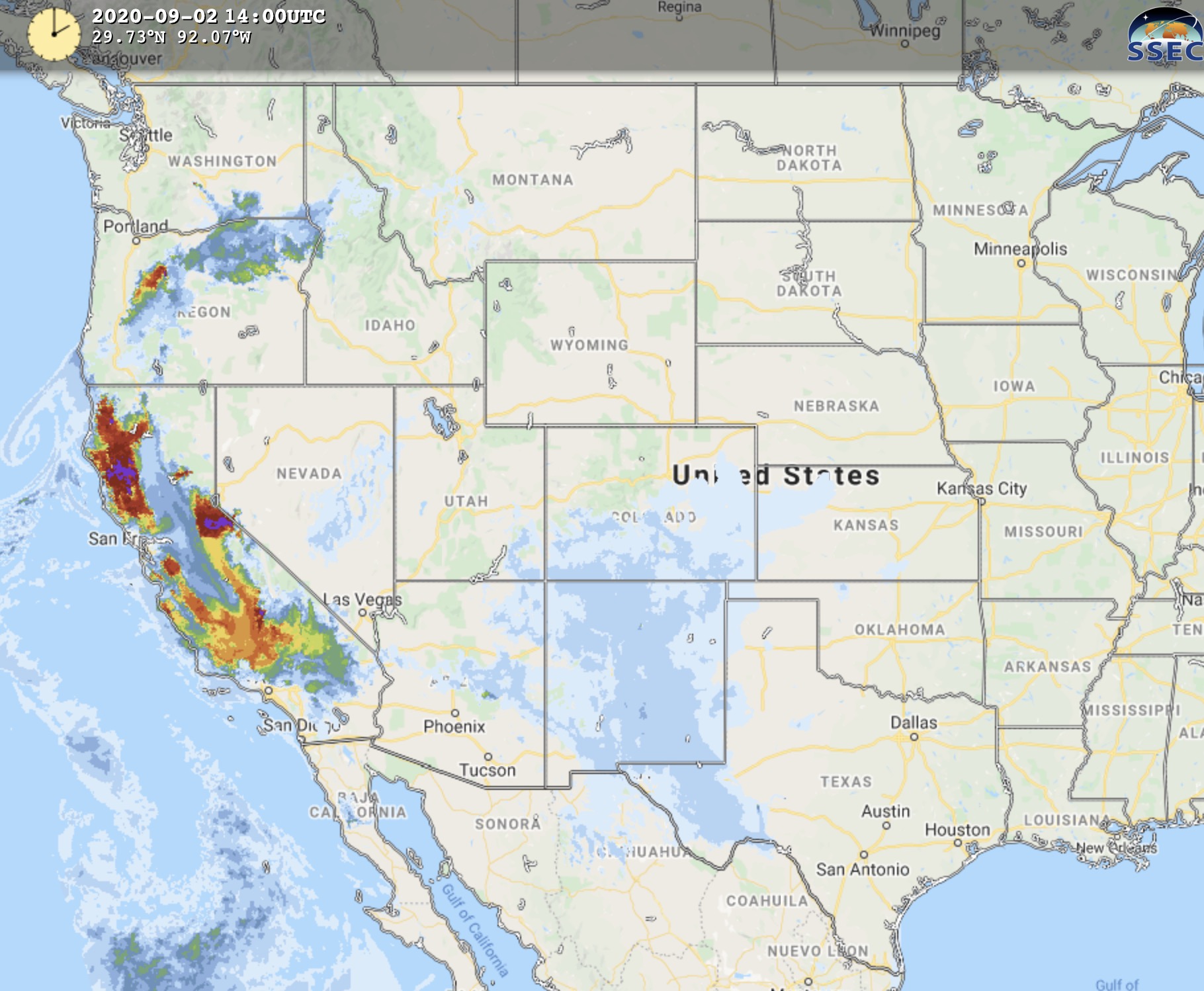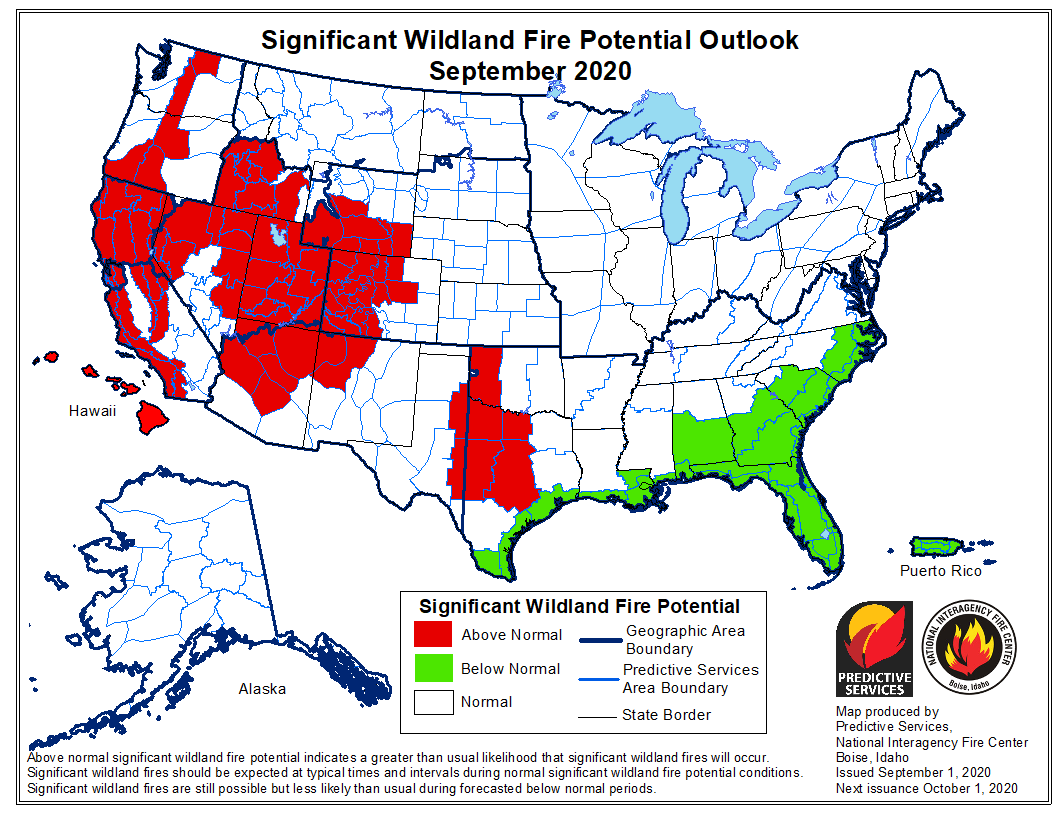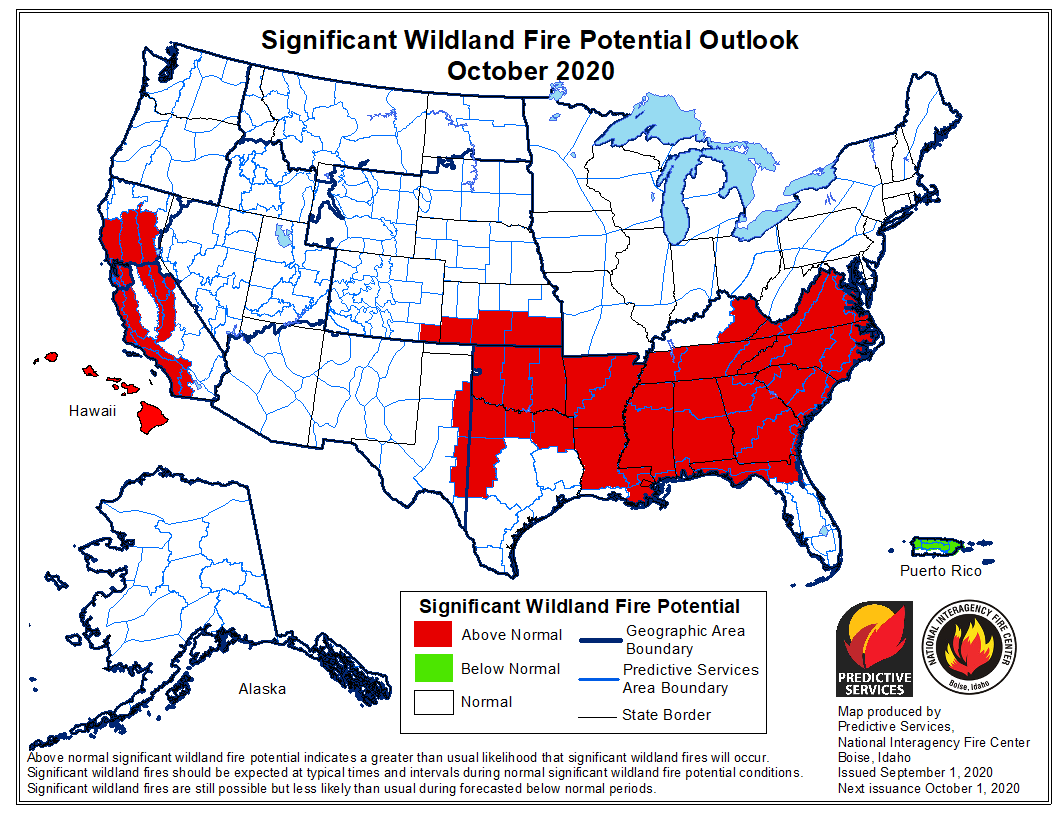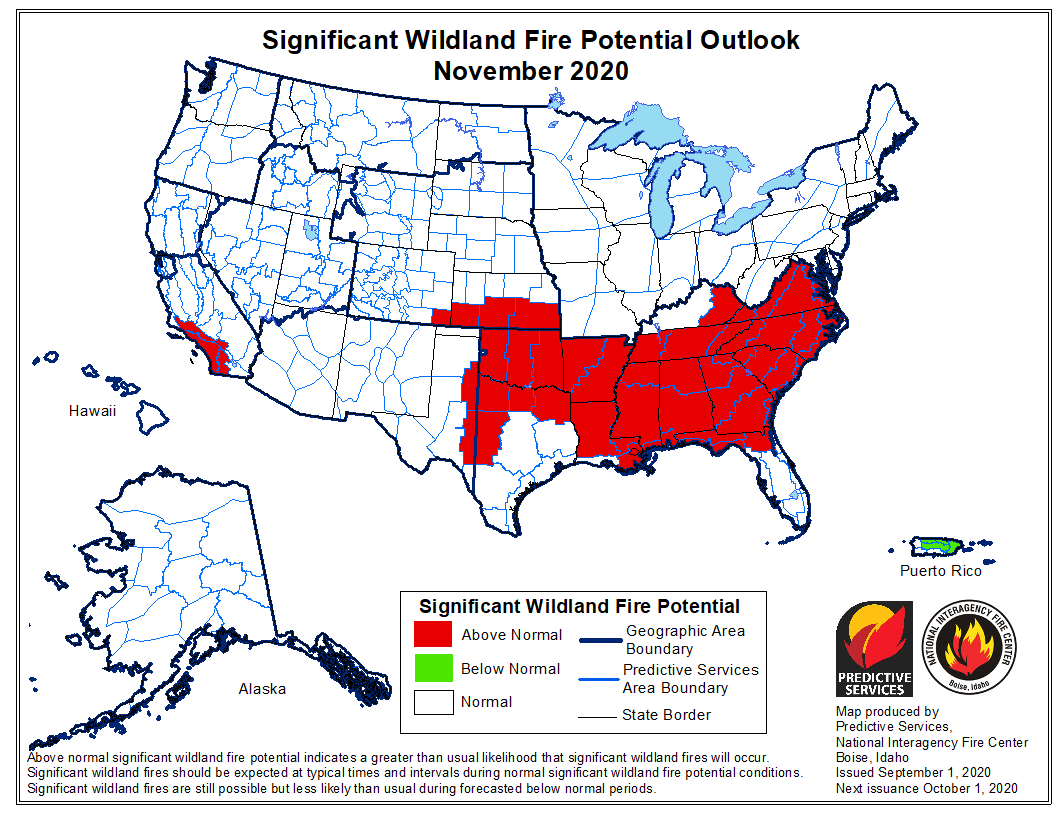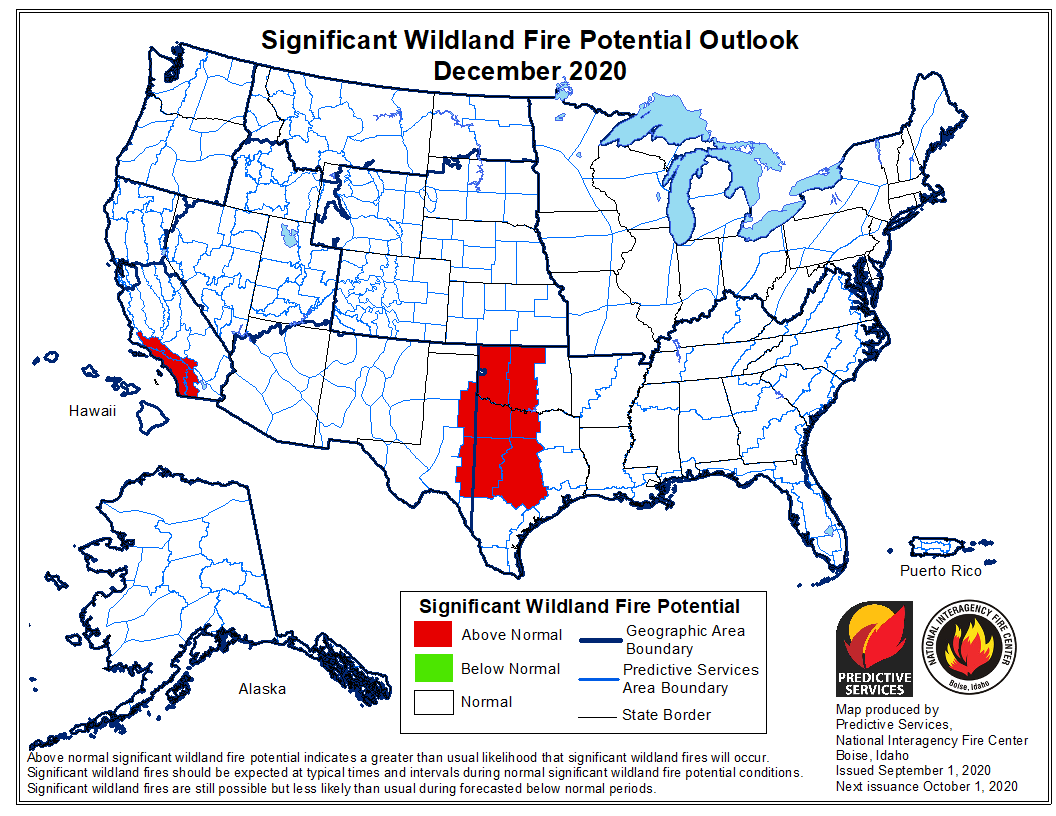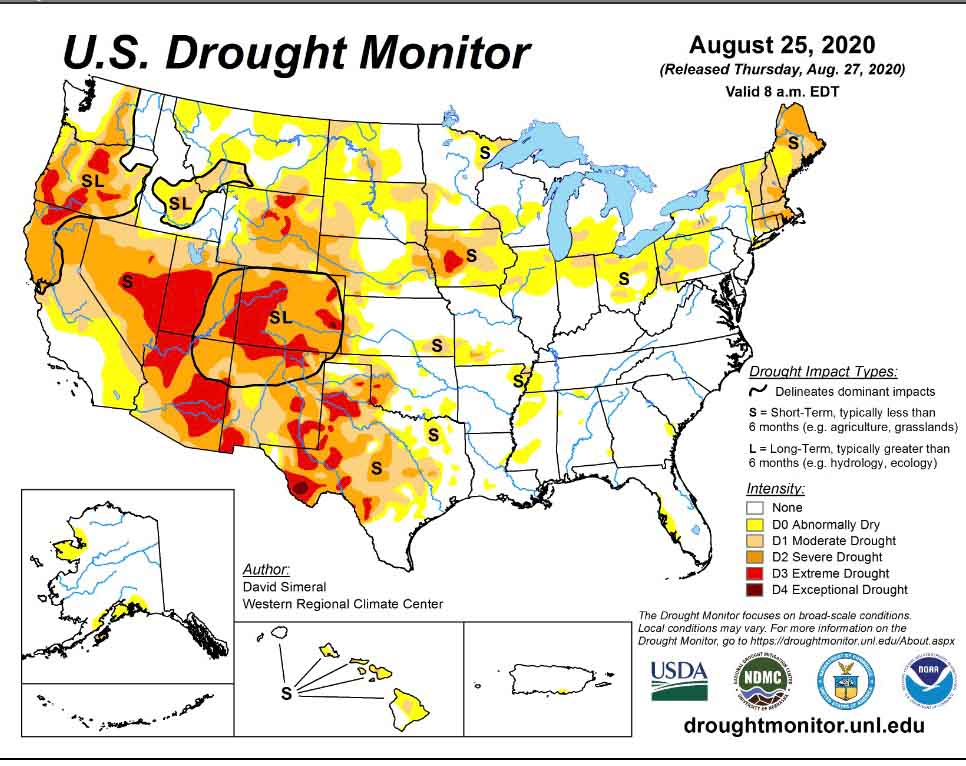This is the forecast for the distribution of near surface smoke from wildfires at 7 a.m. PDT September 2, 2020.
Higher than normal wildfire potential predicted for much of the western U.S. in September
The National Significant Wildland Fire Potential Outlook issued September 1 by the Predictive Services section at the National Interagency Fire Center for September through December predicts that most of the forested areas of the western states, with the exception of Montana, will have above normal potential in September. In October and November that is expected to shift to California and the southeast.
The data from NIFC shown here represents the cumulative forecasts of the ten Geographic Area Predictive Services Units and the National Predictive Services Unit.
Below:
- An excerpt from the NIFC narrative report for the next several months;
- More of NIFC’s monthly graphical outlooks;
- NOAA’s three-month temperature and precipitation forecasts;
- Drought Monitor;
- Keetch-Byram Drought Index.
“A continuation of peak season activity into September is expected across much of the West as drought conditions continue to take hold. Most western regions will experience areas of above normal significant large fire potential as shown on the maps to the left. By mid-month, however, the seasonal transition to fall will begin. Cold fronts brining winds but also precipitation will begin providing relief to the critically dry fuels. Fire activity will begin to diminish as fuel moistures begin to recover. As the days get shorter, overnight humidity recoveries will become greater. This will add further relief to fuels, especially the finer fuels.
“Following a brief pause in activity in California and a cessation of seasonal activity elsewhere across the West, large fire potential is expected to increase in October and November in wind prone areas across the state. The expectation of drier than average conditions and a higher probability of more frequent Foehn Wind events suggests that significant large fire potential will be elevated until winter sets in during December. The fall fire season across the East is expected to be near average but above average across much of the Southern Area due to drier than average conditions associated with a developing La Niña.”
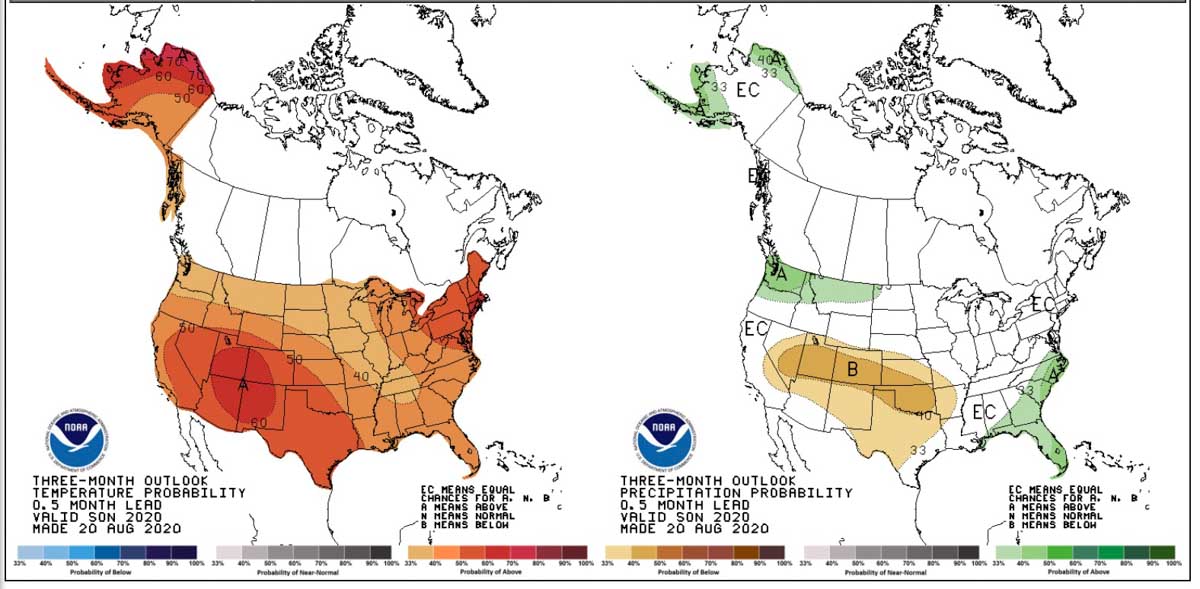
x
x
x
x
August Complex of fires in northern California grows to nearly a quarter million acres
September 1, 2020 | 3:11 p.m. PDT

The massive August Complex of fires in northern California will soon exceed a quarter million acres. The Forest Service reported Tuesday morning the combined size of the fires had blackened 242,941 acres. Most of the completed fire line is on the east side, outside the Mendocino National Forest boundary, but there is also completed line on much of the south side of the Doe and Hull Fires.
The fires are southwest of Red Bluff and west of Corning, Orland, and Willows.
On Monday two large fires within the complex, the Glad and Tatham Fires, burned into and merged with the largest fire, the Doe Fire.
A firefighter was killed in a vehicle accident on the fire Monday, August 31.
There were strong northeast winds on the Complex in the middle of the day Monday which increased fire activity in the area. There is a potential for the same weather and fire behavior Tuesday.
The number of resources assigned to the fire include 11 hand crews, 3 camp crews, 7 helicopters, 51 engines, 18 dozers, 25 water tenders, and 3 masticators for a total of 690 personnel. Considering the size, those numbers are not large.

Firefighter killed while working on northern California wildfire
September 1, 2020 | 3:09 p.m. PDT
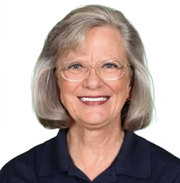
A firefighter-EMT from Texas died in a vehicle accident Monday August 31 while working on a wildfire in northern California.
Fox4 News reported the deceased was “…Diana Jones, a firefighter and EMT with the Cresson Volunteer Fire Department, about 25 miles southwest of Fort Worth. Her son was also a member of the department. Each summer, they would work with a company that contracts with the federal government to respond to wildfires in western states.”
A statement from the Mendocino National Forest said two additional firefighters were involved in the accident; one is receiving medical attention for burns to their hand and arm, while the third received no injuries.
The Press Democrat reported that Ms. Jones was widowed and lived in Cresson, Texas. She had been with the Cresson Volunteer Fire Department about five years.
KQED reported Cresson Fire Chief Ron Becker said Tuesday the community was stunned by news of Ms. Jones’ death.
“We’re all numb. We’re shell-shocked. She’ll be sorely missed,” Becker said.
The firefighters were working on the Tatham Fire, part of the August Complex of fires southwest of Red Bluff, when the vehicle accident occurred.
The Cresson Volunteer Fire Department wrote on their Facebook page, “Our department is numbed by the news and we are hurting.”
“This was a tragic incident and our hearts go out to the family, friends, and colleagues of the fallen firefighter,” said Acting Forest Supervisor Sandra Moore. “Right now we are committed to providing support to those involved, while safely continuing firefighting operations.”
California Highway Patrol is currently leading the investigation. Forest Service officials, Federal Southern Area Blue Team Incident Management, and CAL FIRE Incident Management Team 4 are working to support the families, who have been notified.
The August Complex of fires has burned nearly a quarter million acres, 242,941, the Forest Service said Monday morning.

Our sincere condolences go out to Ms. Jones’ family, friends, and co-workers.
Thanks and a tip of the hat go out to Tom.
Canada to partially fulfill the United States’ request for firefighting help
Australia is considering it
Updated September 2, 2020 | 8:58 a.m. PDT
Early last week the United States requested help from Australia and Canada in battling the wildfires in California and other states. The National Multi-Agency Coordinating Group, through the National Interagency Fire Center (NIFC), asked Canada for four to five 20-person hand crews and requested 55 overhead personnel from Australia.
The three 20-person crews from Quebec will be arriving in Boise Wednesday September 2. They will receive a briefing orientation and participate in fire shelter deployment training. After a one-night rest in Boise, the crews will fly to Reno, Nevada and board ground transportation to their fire assignment on the North Complex in California. The North Complex consists of numerous lightning fires being managed as one incident on the Plumas National Forest.
As for the status of the request for 55 overhead positions from down under, “Australia is on hold for now,” Ms. Cobb said. “They are assessing the need for the types of personnel being requested as our fire situation evolves.”
Australia is approaching the beginning of their 2020-2021 summer bushfire season.
From The Australian Broadcasting Corporation:
The ABC understands anyone who wants to go to California will have to pass strict health tests and age will be taken into consideration because of COVID-19.
Those who go to California will have to quarantine for two weeks when they return to Australia, which [Australasian Fire and Emergency Service Authorities Council CEO Stuart] Ellis said he expected would play a role in deciding who goes.
“That needs to be factored into each (fire) commissioner’s consideration of their people’s availability,” he said.
“Not only will they be absent for the period they are in the United States, but they will also need to spend two weeks in quarantine on return to Australia.”
Queensland will not send anyone because the state is about to enter their fire season and Victoria will not assist due to the health crisis. New South Wales, the ACT, and Western Australia are considering their options.
The final decision is up to each state and territory, but Ellis said he is optimistic Australia will either meet or come close to the requested number.
California has asked for help to arrive by September 6.
It is possible that the fire authorities in Australia may be in a very awkward position. During their extraordinarily busy 2019-2020 summer bushfire season, the U.S. deployed more than 200 U.S. Forest Service and Department of the Interior wildland fire staff to the Australian Bushfire response.
Firefighters in Australia asked to travel to America could think they would be entering a more risky environment by accepting an assignment where the COVID-19 death rate is 21 times higher per 100,000 population — 2.63 in Australia compared to 56.12 in the U.S. The death rate in Canada is less than half of the U.S. rate, 24.75.
Australia and New Zealand sent 44 fire specialists to assist the United States in 2008, and 68 in 2015. They may have helped out in other years also.
The California National Guard and active duty soldiers from the U.S. Army are being mobilized for firefighting duty in the U.S.
Growing up in a National Park Service family
I recently became aware of an article that appeared in the Spring, 1998 edition of “Ranger”, a publication of the Association of National Park Rangers. It was written by Jennifer Blake, the daughter of Bill Blake who when he retired was the Chief Ranger of the National Park Service’s Midwest Region. Bill and I have spent much time together on incident management team assignments and ridden thousands of miles on multi-week motorcycle trips.
Jennifer’s piece describes what it is like for a child to grow up in a National Park Service family. When she wrote it as a 21-year-old majoring in journalism at Northeastern University in Boston, her parents worked at New River Gorge National River in West Virginia where he was the park’s Chief Ranger and she worked in payroll.
Her experiences are probably similar to other children whose parents work for land management agencies.
I asked Jennifer if I could republish the article she wrote 22 years ago, and I didn’t leave it at that — I encouraged her to write an epilog as an update. She said yes, and both are below.
Bill Gabbert
Childhood in NPS Packs Many Memories
By Jennifer Blake
My father is Yogi Bear’s worst enemy. He’s Smokey Bear and Woodsy Owl wrapped into one. My father is a park ranger. And while he never worked at Jellystone Park, his career moved our family across the country three times and gave me the memories and images that defined my childhood.
I can’t think of my father without thinking of his uniform. The forest green pants and famous Smokey Bear hat are as intrinsic to his appearance in my mind as are the color of his eyes. To this day, I feel strangely at home whenever I see someone wearing one.
Memorable Adventures
That uniform came to represent the small adventures that punctuate and color the lives of young children. I remember visits to ranger stations, drives through apple orchards to spy on bear cubs stranded in trees, and trips to mountain lookouts to spy on forest fires the same way most kids remember learning how to ride their bikes. What strikes me most about these memories is the security I felt knowing that my father and all his powers as a park ranger, which in the mind of a young child were numerous and mighty, were never far behind.
Being a ranger was — and still is — more than just my father’s job; it was part of his identity. I was enthralled with that identity and tried to imbibe as much of it as I could. I was born in Fredricksburg. Va., when my father worked at the national battlefield there. His early tales of my ancestors’ feats on the very grounds on which he worked sparked a passion for history I still carry. I’m probably one of the few people who visited just about every major Civil War battle site before the age of 15.
The stories my father would tell me on hikes through the woods were more interesting than any children’s story. If he had any doubts about the attention I gave his words, they were erased when my kindergarten teacher sent home a note telling my parents that I had interrupted a story she was telling to the class: “Bears don’t simply sleep in the winter,” I proudly informed my classmates. “They hibernate.” I pronounced the word as if it were a special secret that had been passed from my father to me — and, in a way, it was.
That same class later went on a field trip to my father’s ranger station. We lived in Elkton, Va., at the time and the station was located in the rolling Blue Ridge Mountains amid the painting of fall foliage. I’ll never forget how proud I was that day. Actually, I don’t know if I, as a 5-year-old, had any real notion of pride. But I do know that the feeling of being special I had on that day — because I was the kid whom all the rangers knew, because I was the one who donned an oversized, yellow fireman’s hat and tried to aim the hose, because it was my father who got down on all fours and growled like a grizzly during the bear-trap demonstration — still strikes me as significant.
The Park Service, in the fashion of the military, creates a surrogate family. Rangers are transferred to different parks across the United States — I’ve lived in Virginia (twice), New Mexico, Arizona, Georgia. Pennsylvania, California (twice), and West Virginia — and each new park presents a new group of friends. I’ve spent many a Thanksgiving and Christmas with other rangers and their families and it never failed to feel like anything but home. Once, my brother and I were in a school production that called for us to run into the audience and return with our fathers in tow. We were living in Yosemite, Calif., and my father had been called out on an emergency — but my brother and I didn’t hesitate to grab our “Uncle Jim,” who followed us obligingly. My father’s office is still one of the first places I visit when I go home. I’m greeted with excited hugs that most people only receive when they visit distant grandparents.
Moving Not Easy
Not that moving around often was always easy. Starting new schools is right up there with root canals and major surgery on my list of fun. The culture shock I experienced moving from California to West Virginia was worse than when I left Boston to live in London.
I left the beautiful surroundings of northern California and a four-room, 65-person school to arrive in the rundown, economically depressed southern West Virginia. I was only interesting to the other kids as an object of torture. (I distinctly remember an episode that involved a greasy, unwashed junior high boy grabbing my book and sticking it down his pants.) Beckley didn’t exactly welcome outsiders with open arms. I cried so hard and so often my first three months that my eyes were always bloodshot and a guidance counselor once pulled me aside to ask if I was on drugs.
Many Benefits
But I know the benefits of “growing up Park Service” have far outweighed the detriments. For one, when I left for college I had few qualms at the prospect of being thrown in with hundreds of new kids. And I still proudly demonstrate the knowledge I gained from my father and our countless trips though his many parks: I got a curious look from a few of my friends the other day when one of them picked up a stone off the street and said it looked like an arrowhead: I quickly pronounced it the wrong material for a true Indian arrowhead.
My father’s career had taken him in many directions — park rangers actually do a lot more than secure visitor’s picnic baskets from pesky bears. He’s taught defensive driving at the Federal Law Enforcement Training Center (a fact that became all too clear when he tried to teach me how to drive); he’s served on presidential protection teams—teams of park rangers assembled whenever a president visits a national park — for Ford, Carter, Nixon and Clinton; he was chosen to work at the bicentennial celebration for the Liberty Bell in Philadelphia, where he held the door open for Queen Elizabeth; and he served a 30-day detail on the ’88 Yellowstone fires, which ravaged what my father calls “the Mother Park.”
A few years after the fire, my family visited Yellowstone. The park was still badly scarred from the fires and my father seemed to have a tale about every singed tree. The force of nature was displayed in the strips of green grass and lush forest that stood untouched and juxtaposed to the fire-ravaged portions. I remember my father telling us that while the fires were burning, it seemed as if the sun never set because the force of the fires produced such an enormous glow.
The sight reminded me of a song about Smokey the Bear my brother and I were taught as children.
Smokey the Bear, Smokey the Bear*.
Prowlin’ and a growlin’ and a sniffin’ the air.
He can find a fire before it starts to flame.
That’s why they call him Smokey,
That was how he got his name.
In ninth grade I attended a youth-in-conservation conference and the leaders taught us that song as a joke. Everyone laughed because I already knew it, but I sang it with pride.
The Park Service celebrates America’s heritage; I celebrate the Park Service as my heritage. My childhood is wound tightly around it — inseparable. I’ve migrated to the city, but I still have a fondness for those famous hats. There’s a Park Service visitor center in downtown Boston. Occasionally, I drag an unsuspecting friend there because it reminds me of home. The paint in that visitor center is the same color brown as in every other Park Service visitor center (my mother has dubbed this particularly drab shade “Park Service Brown’’); it also has the same books, the same signs for the bathroom and the same donation box next to the cash register.
I know if I asked enough of the rangers, one of them would at least know someone who knows my father. And because of that, they know an intrinsic part of me.
Epilog, August, 2020
It has been more years than I care to admit (ok – 26 years) since I lived with my family in a national park. And yet, national parks across the country still feel like home to me.
I recently drove 13 hours to hike in Rocky Mountain National Park. We never lived there, but it still felt like sort of a homecoming the minute I saw an arrowhead. It’s the gift I was given as the kid of a park ranger and I will always cherish and keep it. My brother must feel the same way because he’s a proud park ranger himself now.
A few years ago I was working in San Francisco. I was at a bar and seated next to a party who had just come back from Yosemite National Park (where I was lucky enough to live from the time I was 7 until I turned 13). I couldn’t help but listen to them as they spoke in awe of what they’d seen. And then one of the women mentioned the small schoolhouse in the valley (my old schoolhouse!) and said she’d love to talk to a someone that had attended school there. I was proud to turn around and introduce myself.
National parks are one of the most constant things in my life. I’ve continued to move around as an adult and my career path is nothing like I thought it would be when I wrote the original article so many years ago. But I still smile whenever I see someone wearing a green and grey uniform with a Smokey Bear hat. I’ve pretty much been a city girl since I moved to Boston for college, but national parks will always be one of my touchstones.
*From Bill: When the Smokey Bear fire prevention campaign began in 1944 he was known as just that, “Smokey Bear” without “the” in the name. But in 1952 Steve Nelson and Jack Rollins wrote what became a successful song named “Smokey the Bear”. They said adding “the” enhanced the song’s rhythm. A Little Golden Book published about the bear in 1955 followed the songwriters lead and also used the incorrect “the” version of the name. All this created confusion, but the name of the fire prevention icon is and always has been Smokey Bear. A new version of the song has been written correcting the name.

